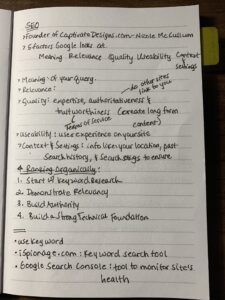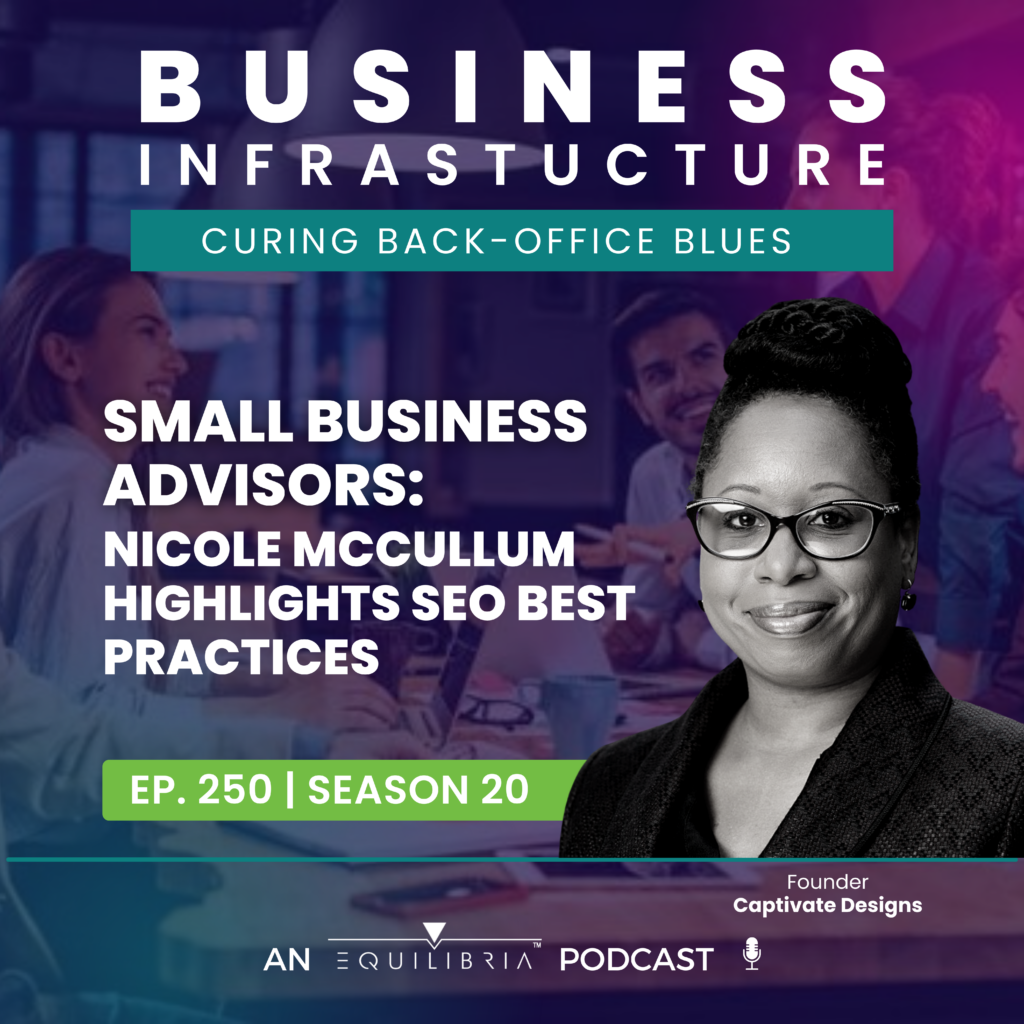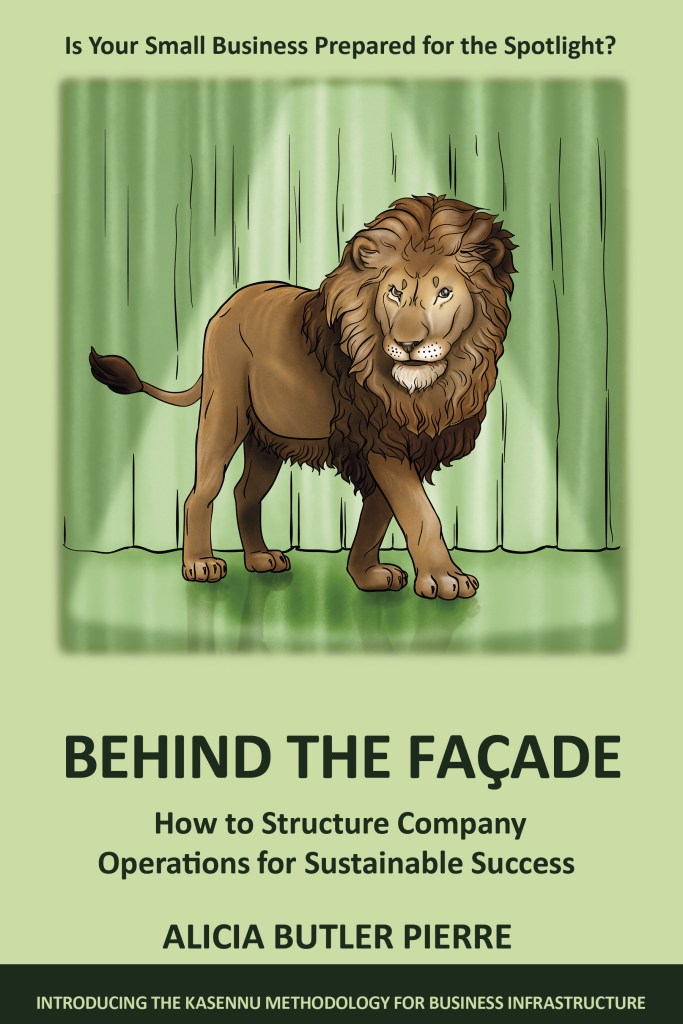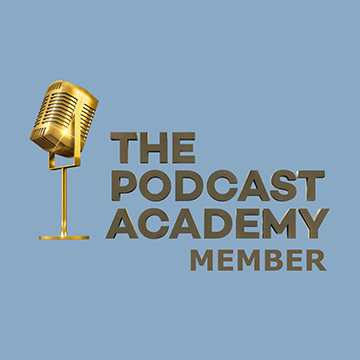Getting found online in an increasingly noisy world is no small feat. It requires more than having an attractive website. There’s an art and science to ranking on the first page of an online search. Once visitors come to your organization’s website, your number one goal is to keep them there and…to convert them!
This episode is underwritten by Equilibria, Inc. the company behind this podcast where we design scale-ready business infrastructure for fast-growing small businesses.

Welcome back to Season 20 of the Business Infrastructure podcast – the show where we share operational tips, strategies and tactics to help you cure any back-office blues you might be experiencing. This season you’ll hear from 12 small business advisors, each with a unique skillset they’ll share with you.
Our next guest has deep expertise in search engine optimization. I’m warning you now – you’ll want to download this episode and add it to your digital library for future reference. She’ll cover a lot of ground in a relatively short time.
I guarantee you won’t be disappointed!
This is Episode 250 – Nicole McCullum Highlights SEO Best Practices
My name is Nicole McCullum. I am the founder of Captivate Designs. We’re a web design, digital marketing, and training company, and we specialize in SEO we specialize in helping small businesses keep their pipeline full so they never have to worry about where their leads are coming from.
Thank you so much, Alicia, for having me. It’s great to be with you here.
Okay, I’m freaking out a little here. Ever since I saw Nicole speak at America’s SBDC conference in San Diego in 2022, I’ve become a fan. You should have seen her – she was incredible! First of all, the fact that she kept a room full of people highly engaged on the last day of that conference was impressive in and of itself.

And I have to say, not only that is I was nervous speaking so early in the morning cuz figured who was gonna get up at that time and the turnout was amazing. So that’s the commitment of the SBDC advisors such as yourself, you really wanna help small businesses.
And Nicole is equally passionate about helping small businesses. Considering her deep knowledge and expertise in helping companies get found online, in true entrepreneurial fashion, her career didn’t start in search engine optimization, also known as SEO.
So, my first business was a real estate school. We did, a salesperson’s broker and continued education training, for people who wanted to start a career in real estate. And I paid $5,000 for a website. It didn’t really do anything for me, and I had to figure out how to make it work. And that’s when I started with Google Ads and, search marketing as a channel. And I started to get results to
get people to fill my classrooms after a lot of trial and error with a lot of different types of, advertising. So, I did bus, TV, movie theater, you name it, right? Because I was a newbie, I was 24, I thought, you know, put an ad, you’re gonna get you, your classroom full. And that was a wake-up call because it did not happen that way.
And this was back in 2004 and I wasn’t even aware of resources such as SBDC, for example. So, I was basically trial and error and, stumbled upon, Google Ads and started using ads, doing it myself to get people into my classrooms and got it to work. And I realized, you know, what, if I was having this problem where I build a website and think, okay, build it, and they would come and build it, and they didn’t, other small businesses were in the same predicament as I was. And I set out to, you know, really, bring this awareness to small businesses is one of the reasons why I speak at conferences. And I do a lot of training in addition to offering SEO as a service. But that is really how it all started.
Nicole couldn’t have imagined that her self-education in SEO would eventually lead her to abandon her real estate training business. I was curious about how she pivoted and started a business around her newfound skillset.
When I started, I started as a web design company to help people with their websites. And I actually started doing SEO myself. So my business and people who were finding me doing SEO, true SEO, started asking me to do it for them. And so, that’s how I really got into SEO.
I was doing it for a couple of years and then, because of course, I was bankrolling it myself, I went back out to work for like a year or so, and then I started Captivate while at my job on my plan palm pilot, I had a palm pilot. I dunno if ever need to remember that.
Oh yes, I remember that!
I distinctly remember, you know, creating proposals and, and emailing them to myself, and then sending them to a prospect directly from my palm pilot because I didn’t wanna send them from my job email. so, basically, I was doing that part-time, as a side hustle. This was in 2006. I wasn’t quite ready to leave my job but didn’t see eye to eye with my supervisor at the time, and decided to leave. And, you know, the rest, as they say, is history.
Indeed, it is. Nicole left that regular 9-to-5 job and didn’t look back. Her side hustle became her full-time pursuit. 15 years later, she’s still at it. Though the attributes for effective SEO have changed over the years, her commitment to the craft of being found online hasn’t. It begs the question, what exactly is SEO? How does Nicole define it?

So, SEO, as you said, stands for search engine optimization, and my definition is it’s the process of performing key tactics on and off your website so that you can get found by the people that are searching, for the keywords that are related to your business. And there are things that you need to do on your website, and then there are things that you need to do off your website in order for you to show up and get found in the search engines.
And when it comes to doing those tactics for search engine optimization, it’s not like you do something and then you expect to see instant results one week later, right? You have to give it time. About how much time would you say on average?
Generally, it takes about three to six months for you to start to see the results. However, it can’t take long if you’re in a super competitive, industry or niche, but generally, it takes three to six months, for most small businesses, just to start seeing results.
If you’ve never done any SEO for your company’s website, then you might be wondering how to start. Well, Nicole’s company, Captivate Designs, starts with an audit.
When we take on a client, we usually start, with a creative brief to understand the client, their needs, their audience, what products or services they’re selling, and what they wanna prioritize. Because, you know, everything that we do is driven by strategy. So, it’s very easy for small businesses to say, “I want to rank on Google.” But, maybe there is more than one product or service that you’re selling and maybe you want one to be more profitable than the other. And so maybe you wanna stop prioritizing that because you might have a limited budget or resources.
Alright, now seemed like a good time for me to bring out a notebook where I recorded notes from Nicole’s presentation that I mentioned earlier. When I found the specific notes I took, I was reminded of Nicole talking about the four pillars of SEO and wondered if she could explain each of those pillars here on the show.

I like to think of keyword research, which is the first pillar, as the foundation of SEO. I think that one of the biggest mistakes that I see small businesses make is not choosing the right keywords to target in the first place.
And so going through that process of identifying, what your target audience is searching for on search engines like Google, and whether that keyword is relevant to, you know, what you offer, and also looking at the competition for that keyword. How long is it gonna take you to rank for that keyword? And also, the type of keyword because, we look at the intent behind the keyword. Is it a
keyword that’s informational intent, or is the keyword that’s transactional intent? So that is an entire process that we go through before we even start optimizing your website.
The second pillar is on-page optimization.
That is really the process of demonstrating to search engines that your website is relevant to the specific search queries or keywords that you wanna get found for on search engines.
That brings us to the third pillar – off-page optimization.
That is the process of building authority. Demonstrating to search engines that you can trust this website, this is an authoritative website. It’s an authoritative website because others are citing this website or are linking back to it because of the quality of the content on the website.
The fourth pillar is one that Nicole says is often overlooked – the technical foundation of your website.
What, if your website doesn’t provide a good user experience, then that is also going to affect your SEO and your chances of ranking high in the search engine results. So everything from whether search engines are able to crawl and index your website because maybe, your server is taking too long to load and it times out and search engine is not able to crawl your site and add it to their in the index or whether not your site is mobile friendly.
So there’s a number of things that we look at, from a technical SEO standpoint as well. It’s never just one thing and it’s never, you know, I do SEO today, and that is it. it’s done. SEO is a process of continuously improving your website to not only create content that’s going to be attractive to users and search engines, but also that’s gonna provide a good user experience as well.
Speaking of page speed, as I continued thumbing through my notebook I came across a short list of three key things Nicole stressed that we should consider regarding our websites. Page speed was one of those things. Another is the fact that less than 10% of visitors to your website will purchase initially. So, if you’re selling something on your site, then don’t expect first-time visitors to purchase it right away.
Right. Not just selling, but even for someone to submit a lead if you provide a service. And the reason for that is because as consumers, there’s a process we go through. That process is referred to as the buying journey. You might have heard the terms top of the funnel the bottom of the funnel. And starts with awareness and then moves to consideration or evaluation and then purchase, and then ultimately to post-purchase. So think about it, Alicia, I know you travel quite a bit, and when you are booking a trip and you’re maybe looking for a hotel, do you just look at one hotel or do you look at several before you ultimately make a decision? You’re not going to book that trip the very first time you visit the website. You will do it after you’ve evaluated the options that are out there.

And then ultimately, once you come to a decision, then you would go back to one of those several websites that you look at and make a decision. And so your target customers are going through that exact process most of the time. So you need to think about that. you need to think about ways that you’re gonna continuously engage your website, visitors, because it’s one thing to create that awareness, but how do you continue to stay in front of them after you create that awareness to nurture that relationship and move them from the top of the funnel to the bottom of the funnel?
And that brings us to the third point on that list in my notes. It’s the fact that, on average, visitors to your website are looking at seven other sites to compare your products and services against. I asked Nicole to elaborate on that.

Absolutely. Yes. So, a lot of times I talk to small businesses, and they say, “Well, I don’t really have competition.” Well, you do have competition, whether that is a direct competition or indirect competition. So direct competition is I sell SEO services, someone else who sells SEO services is going to be a competitor to me, right? but a small business has a finite budget. And so they have to
decide whether they’re gonna do SEO or whether they’re gonna invest in social media.
So even though someone else doesn’t do SEO, that person that does social media or that person that does PR, or that person that does podcast sponsoring, they’re competing for the same dollars, right? So you always have competition regardless of if that personed did the exact same thing as you or not because you’re competing for the same dollars.
Going back to my written notes, I next noticed a listing of five factors that Google looks for in ranking a webpage.
So, the first thing is…meaning.
No, there isn’t anything wrong with your audio. But you do have to come back after this quick commercial break to hear Nicole explain each of those five factors that Google looks for when ranking a webpage.
How do you know if your business is growing faster than you can keep up with? If you have trouble keeping up with things like deliveries and projects. Your customers are angry, team turnover is high, and the complaints are piling up. Where can you go for relief? How can you save your business from the chaos of unmanageable, fast growth?
It might be time to build business infrastructure. Business infrastructure is a system for linking the people, processes, tools, and technologies that act as the heartbeat of your back-office operations. It gives your fast-growing small business a stable foundation to not only continue growing but to scale in a profitable, sustainable, and repeatable way.
That’s why if you want a business that can consistently operate without your daily presence, then the Smooth Operator course is for you. It’s an online introductory course on business infrastructure that can provide you with proven tools, tactics, and techniques to calm the chaos and restore order. Go to SmoothOperator.courses to learn more. That’s SmoothOperator.courses.
Alright, we are back! And before the break, SEO expert Nicole McCullum was just beginning to explain the five factors that Google looks for when ranking a webpage. The first factor is meaning. Listen as Nicole explains.
Meaning is when someone conducts a search. Is the search relevant to the specific webpage because search engines don’t rank website search engine rank individual webpages? So does the word appear anywhere on the page that you’re trying to rank for that specific keyword?

Exactly, because think about it, okay. if you offer different services, let’s say you offer to consult, and then I’m not, a service might be coaching, for example. If someone’s searching for a business consultant, the search engine wants to rank your business consulting page and not your business coaching page so that’s really important.
Okay. The second factor is relevance.
Meaning and relevance go together because relevance is, okay, does the page that you’re trying to rank, is it relevant to that keyword that was typed into the search engine as a query and hopefully that keyword is relevant to your business as well.
Okay. Factor number three, is quality.
Yes. So, the search engines are also looking at the quality of your website content and the quality of the user experience on your site.
They are looking at whether there are grammatical errors in your content, but it’s also looking at, whether the content is what is called thin content, basically shallow content that doesn’t really go into a topic in an in-depth way. So looking at the overall quality of the content, the quality in terms of grammar, but also in terms of depth of the content as well.
To make sure that you’re not just kind of, I guess, cheating to be found.
Well, not only that is that the search engine wants to rank a piece of content that will leave, the searcher feeling fulfilled. And so if you Googled, How to do SEO, and it was just some basic things that really didn’t give you what you were seeking, that wouldn’t really make you happy, and that would not have been a good experience. And so you would need to go and search again and find another website to fulfill, that need that you have. And so that’s not what the search engines want. They want when someone clicks on a page that they’re going to feel fulfilled in that result that they got.
I couldn’t help but wonder how Google actually measures webpage quality.
Think about it, Google owns Chrome. So they get a lot of data, just from people who are using Chrome browsers as well. And another thing is that many of us use Google Analytics, which is another Google product the whole point of that is to provide data on website behavior. And so that’s another way.
All right. Going back to our five factors. So we talked about meaning, relevance, and quality. Number four is usability.
That goes specifically to the user experience, everything from the font size. Is the font too small? How long are your paragraphs? Are your paragraphs too difficult to read? What is the readability level? So typically you wanna have your text lines not be more than 75 characters per from a user experience standpoint per line on your website because then it makes it more difficult to look.
Typically, you wanna keep your paragraphs to four to five sentences per paragraph. So, it looks at, again, the mobile-friendliness, the page speed, and also, core web vitals, which is a set of metrics that Google, uses that measures the loading, interactivity, and stability of your webpage, and how long it takes for those things to occur.
And that is built into, the Google Page experience score that Google looks at. That is part of the algorithm to determine what is the overall experience of a webpage. And by the way, you can look at your page experience and your core web vitals in Google Search Console, which is a free tool, that Google provides, that allows you to monitor, your core web vitals and the page experience and see what Google is seeing and what errors they might be encountering so that you can improve your SEO.
Hmm, interesting. Okay. The fifth factor is context and settings.
So, context and settings are basically, if someone is searching for football in the US and someone search for football in Europe. Those are two different types of searches. Someone searching for football in America, they’re looking at American football. If they search for football in London, they’re thinking about soccer, but also your settings, where are you based locally So if someone searched for football in, New York, they might more likely see, the Giants or the Jets.
Similarly, if someone searched for football in Las Vegas search results would yield the Raiders. As important as those five factors are for ranking a webpage, Nicole mentioned the fact that Google also looks at the experience, authority, and trust of your overall website.
Expertise has to do with how much knowledge the person that’s creating a piece of content has. Google actually wants you to hone in on a topic and demonstrate real expertise on that topic and authority. Again, that goes back to whether other people are citing you, for example. And then trust is, can we trust this website? Do you have an About Us page on your site? Do you have your privacy policy on your site? Do you have your terms of conditions on your site? Is your site secure?

Website security is about having SSL or Secured Socket Layer protection on your website. Without getting too technical, it’s a way to protect data sent across the internet via encryption. You’ll know a website has SSL when it starts with https instead of http. As important as SSL is for your website, so is having a responsive design.

Responsive is whether or not the website is gonna adapt to the different screen size that is being viewed. A responsive website stays the same whether you’re browsing on a desktop or mobile. However, the experience might be different from desktop to mobile, because if you have very long content on a desktop, then on mobile, the experience is gonna be a little bit not the best because your content is not specifically tailored for mobile.
Okay, as we get ready to wrap up, I visited my notes one more time. Sprinkled throughout them are specific resources, some of which Nicole already mentioned like Google Analytics and Google Search Console. There was another one called iSpionage.
iSpionage is a keyword research tool. And it helps you to do competitive keyword research. One of my favorite tools that I use is SEM Rush. So, it’s also a paid tool, but it’s a little bit more expensive than, iSpionage.
Another tool is BuzzSumo which Nicole said can also help you do competitive keyword research in addition to generating content ideas. When I asked her to share more tools she said that although there are so many, she thought it was best to categorize some of them according to the four pillars of SEO.
Generally keyword research, you’re going to be using tools like SEM Rush, you’re gonna use, Google Keyword Planner, you’re going to use iSpionage. There are others like AHREF, for example. then on-page optimization. So, most websites have a built-in SEO plug, and plug-in section. If your site is in WordPress, you’re probably using something like SEO by Yoast. But then you would also, need to make sure you’re submitting a site map to Google.
If your site does not have a built-in site map, you might create one on xml hyphen sitemaps.com, for example. then, from an SEO standpoint, you would want to do on-page optimization and create structured data, which is a way for you to mark up your content and make your website content more understandable to search engines.
So you can use something like the Google Structured Data Markup helper. you can also go to schema.org and you can learn more about that. And then for, off-page optimization, you’re building links, so you might use a platform like yex.com, for example, to submit your site, to local business directories. You can also use, AHERF or SEM Rush to do competitive backlink analysis. and then from technical SEO. You might use Google Page speed, an insights tool to check your website page speed on your website, core vitals. You might use their, mobile-friendly, testing tool to see if your site is mobile-friendly. There are so many tools that you can use. we could probably be here all day.
But unfortunately, we can’t be here all day, so suffice it to say you’ll just have to reach out to Nicole yourself to find out the possibilities that exist for getting your company found online.
People can get in touch with me on my website, CaptivateDesigns.com. you can feel free to request more information by filling out our contact form there. Or give us a call and be happy to, either discuss your SEO needs with you or point you in the right direction.
And do you work with people all over the world? Or is it..
Oh, absolutely. I’ve worked with people in Ireland and Marrakesh and Prague, you name it.
And last, but certainly not least, I asked Nicole if she had any additional resources or parting words of advice she’d like to share with us.
One thing is if it’s something you wanna tackle for yourself, once you go to my website, I actually have an online SEO course that you can sign up for to learn more about SEO. I do wanna tell people that SEO, again, it’s a long-term strategy, so it’s not something that you’re gonna start seeing quick results from, but once you start ranking, the results are gonna start paying off for you.
Pace yourself. Do a little, every day. The best way to eat an elephant is one bite at a time and that’s what you need to do with SEO. So, it’s kind of like trying to lose weight. You don’t just do it for one week and expect everything to happen. You have to put in the work. and that is true with SEO as well.
Well, Nicole, thank you so much! I appreciate you more than you can possibly know because I know how busy you are.
Oh, the feeling is absolutely mutual! Thank you so much for having me.
Let’s give it up for Nicole McCullum! As you can tell, she’s very thorough so that should let you know just how detailed and committed she and her team will be if you work with them. Be sure to check out BusinessInfrastructure.TV to access links to all the resources she shared during this episode. Again that’s BusinessInfrastructure.TV.

Thank you so much for listening! If you enjoyed this episode, then subscribe to the show and leave a five-star rating and review wherever you’re listening.
Coming up in the next episode, you’ll hear from a small business advisor who leverages his background in accounting to teach entrepreneurs like us some key metrics to consider as we strive for greater profitability, equity, and cash flow.
As you continue navigating the operational challenges of managing a fast-growing small business, just remember to stay focused and be encouraged. This entrepreneurial journey is a marathon and not a sprint. So don’t grow alone! We’re here to support you so don’t hesitate to reach out to us.
This podcast was written, produced, and narrated by me, Alicia Butler Pierre. Audio editing by Olanrewaju Adeyemo. Original score and sound design by Sabor! Music Enterprises.
This is the Business Infrastructure – Curing Back-Office Blues podcast.




















